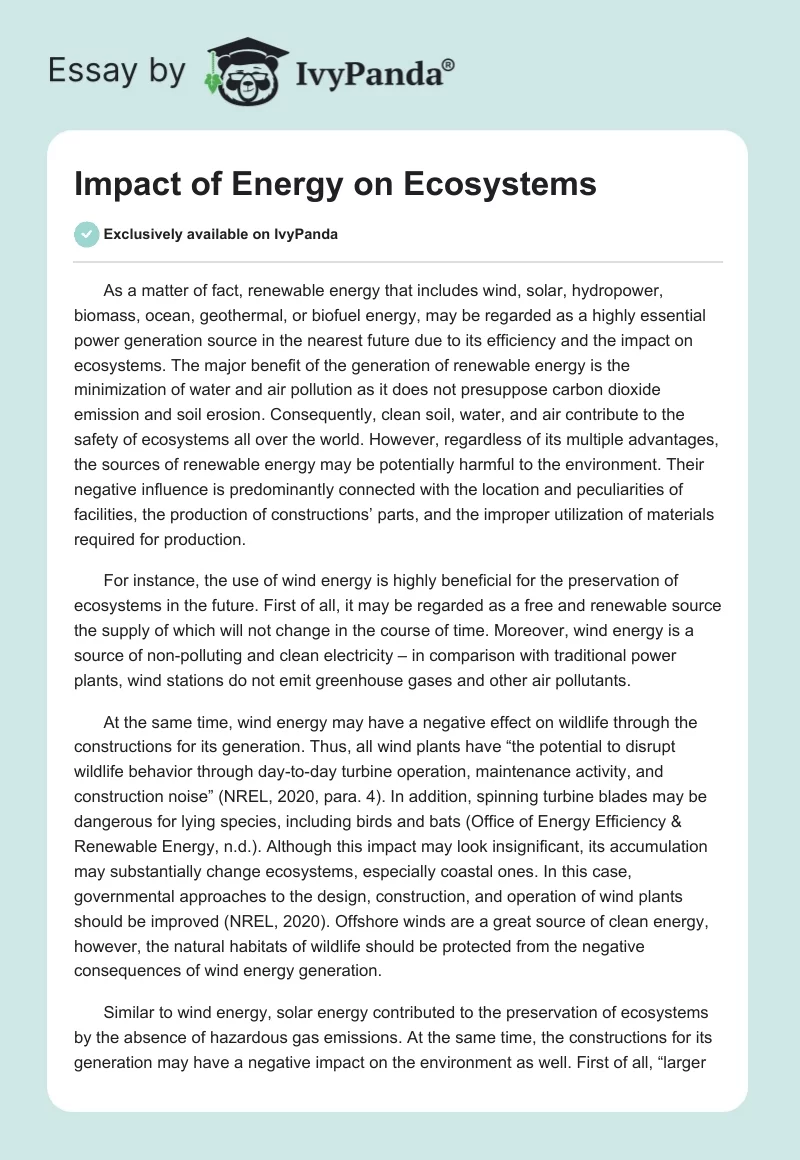As a matter of fact, renewable energy that includes wind, solar, hydropower, biomass, ocean, geothermal, or biofuel energy, may be regarded as a highly essential power generation source in the nearest future due to its efficiency and the impact on ecosystems. The major benefit of the generation of renewable energy is the minimization of water and air pollution as it does not presuppose carbon dioxide emission and soil erosion. Consequently, clean soil, water, and air contribute to the safety of ecosystems all over the world. However, regardless of its multiple advantages, the sources of renewable energy may be potentially harmful to the environment. Their negative influence is predominantly connected with the location and peculiarities of facilities, the production of constructions’ parts, and the improper utilization of materials required for production.
For instance, the use of wind energy is highly beneficial for the preservation of ecosystems in the future. First of all, it may be regarded as a free and renewable source the supply of which will not change in the course of time. Moreover, wind energy is a source of non-polluting and clean electricity – in comparison with traditional power plants, wind stations do not emit greenhouse gases and other air pollutants.
At the same time, wind energy may have a negative effect on wildlife through the constructions for its generation. Thus, all wind plants have “the potential to disrupt wildlife behavior through day-to-day turbine operation, maintenance activity, and construction noise” (NREL, 2020, para. 4). In addition, spinning turbine blades may be dangerous for lying species, including birds and bats (Office of Energy Efficiency & Renewable Energy, n.d.). Although this impact may look insignificant, its accumulation may substantially change ecosystems, especially coastal ones. In this case, governmental approaches to the design, construction, and operation of wind plants should be improved (NREL, 2020). Offshore winds are a great source of clean energy, however, the natural habitats of wildlife should be protected from the negative consequences of wind energy generation.
Similar to wind energy, solar energy contributed to the preservation of ecosystems by the absence of hazardous gas emissions. At the same time, the constructions for its generation may have a negative impact on the environment as well. First of all, “larger utility-scale solar facilities can raise concerns about land degradation and habitat loss,” and they cannot be united with lands for agricultural purposes (Union of Concerned Scientists, 2013). In addition, the manufacturing of concentrating solar thermal plants and photovoltaic solar cells required for the generation of solar energy requires the use of hazardous materials, such as copper-indium-gallium-diselenide, gallium arsenide, cadmium-telluride, sulfuric acid, 1,1,1-trichloroethane, hydrochloric acid, hydrogen fluoride, nitric acid, and acetone (Union of Concerned Scientists, 2013). If these materials are not utilized properly, they may lead to serious environment contamination and the destruction of ecosystems in the future.
Nevertheless, the negative impact of renewable energy cannot compare with the influence of non-renewable sources. The most notorious effect is greenhouse gas emissions that lead to air pollution, the depletion of the ozone layer, climate change, and the related destruction of ecosystems. In addition, due to hazardous gases released into the atmosphere, acid rains occur and cause water pollution and the destruction of wildlife. For instance, they damage trees and weaken forests ecosystems. Thus, regardless of the fact that renewable energy cannot be regarded as completely safe, its impact on ecosystems is less negative and may be mitigated more due to proper strategies of constructions’ location and hazardous material utilization.
References
NREL. (2020). Wind energy and wildlife share future in the skies and seas. NREL. Web.
Office of Energy Efficiency & Renewable Energy. (n.d.). Environmental impacts and siting of wind projects. Office of Energy Efficiency & Renewable Energy. Web.
Union of Concerned Scientists. (2013). Environmental impacts of solar power. Union of Concerned Scientists. Web.


